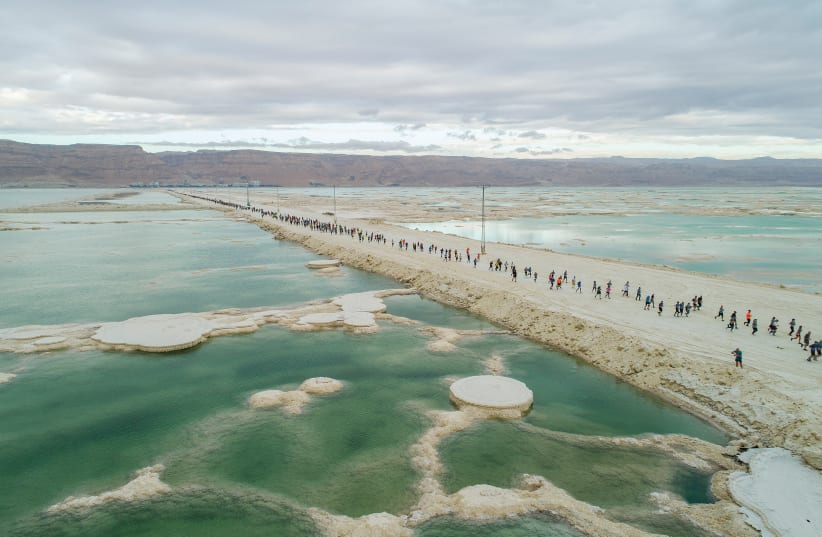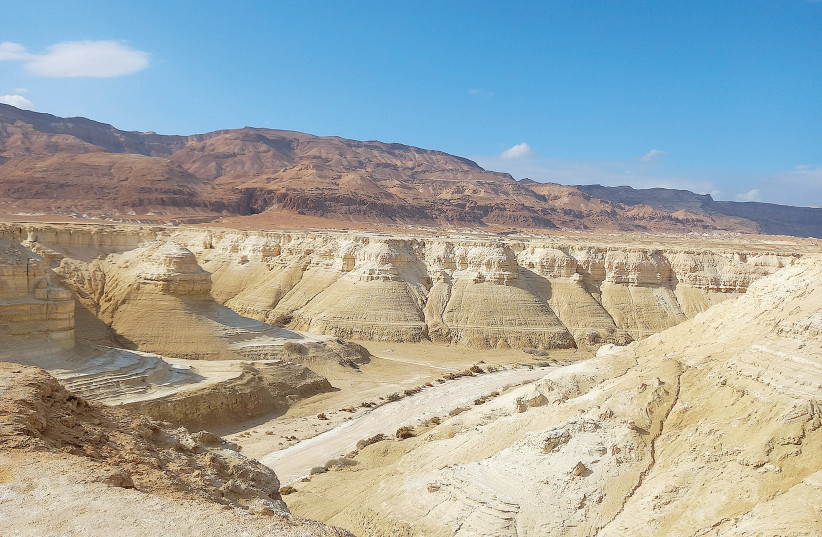A visit to the lowest place on Earth can be surprisingly uplifting. A group of journalists was recently treated to a press tour of the Tamar Regional Council area now branded as Dead Sea Land. The trip was planned for February 2, the day before the Dead Sea Marathon, and gave us a chance to see the preparations for the mammoth event, as well as a taste of the year-round attractions.
The marathon is a definite highlight for the region. Tamar Regional Council head Nir Wanger described it as a flagship event, with some 7,000 participants, 500 of them coming from abroad from some 40 countries.
The event attracts families and dedicated marathon participants with 5 km. and 10 km. courses suitable for those who want to run or walk. Other tracks are the 21.1 km. half marathon, the 42 km. course around the southern Dead Sea basin and a 50 km. ultra marathon.
Raz Lugassi, tourism director of the Tamar Regional Council, noted some of the features that make the Dead Sea Marathon stand out, and we got to check them out at a more comfortable speed. The starting line is positioned at Ein Bokek beach, between spectacular desert mountains, majestic palm trees and the extraordinary Dead Sea salt crystals. It’s a point where the blue skies meet the blue waters. The flat ground has minimal asphalt. “A flat race means a faster pace,” Lugassi noted.
There is no doubt that one of the major features of the race is that all runners head east, crossing an embankment that connects Israel and Jordan, in effect passing an unmarked international border in the middle of the southern section of the Dead Sea. Access to the embankment is open for the day of the marathon alone. “Unique” is an overused word, but in this case, it is fitting. There is no other marathon amid such scenery.
“There’s no way not to take good photos here,” enthused one journalist, clicking at the salt pillars whose tops dot the water.
There is something relaxing about the area. It’s in the air. The Dead Sea mud is acknowledged as therapeutic and being so low – some 430 meters below sea level – the sun’s UV rays are naturally filtered out. It is also the sort of place where locals joke that you can be assured of a warm welcome: “There are two seasons – warm and hot,” jokes Wanger.
Leaving behind a wet wintry Jerusalem, the temperature on the day we ventured to the Dead Sea was perfect: 21°C, blue skies with the sort of clouds that automatically make you look for different shapes. (I swear I spotted a cloud whale hovering above the waters.) Wellness is a Dead Sea state of mind.
The Negev offers multiple opportunities for time travel: traveling back in time along the ancient Nabatean Incense Route and along UNESCO Heritage Sites. We passed close to Masada and the Qumran caves on our way to Ein Bokek.
With a tight itinerary, having checked out part of the marathon course at a leisurely pace, we turned our sights on a road less traveled. We were treated to a jeep tour in Nahal Sdom, the biblical Sodom. You’re never too far from civilization in the Negev, from contemporary civilization to biblical.
Ali, our driver, a Bedouin born and raised in the Negev, was happy to share some local lore and laws. We passed by towering cliffs of salt, caves and occasional acacias (the green being an indication of underground water). He showed us how to use chalky minerals to protect the skin from the sun; pointed out plants that could be eaten; and how to tell the difference at night between a dangerous animal and a benign one: The eyes of predators face forward, the eyes of the preyed upon look to the side. He also explained the multiple uses of the Bedouin keffiyeh: to protect the head from heatstroke, the face from the sun’s rays, the nose and mouth from the dust and sand, and, in an emergency, to serve as a bandage.
Today, many of the customs and traditions are disappearing, and the jeep has replaced the camel for transport, he noted. We enjoyed the jeep ride, although it would be a stretch to call it traveling in comfort, but I could see the appeal of hiking on foot along the well-marked Israel Trail. The desert was calling.
As we took a break at a spot overlooking a huge desert crater, I couldn’t decide whether I felt on top of the world or on the edge of it.
Ali trotted out the joke about being able to sleep out in a million-star hotel, under the open sky. Accommodation in the area ranges from camping, glamping, caravans – we saw cute converted VW van-caravans at Ein Gedi – and three- to five-star hotels.
Seven more hotels are planned for the area to cater to the growing number of visitors and provide jobs. Wanger has a vision in addition to having Jordanian workers crossing the Dead Sea on a daily basis, helping boost the economy on both sides of the waters.
The Tourism Ministry notes that among the advantages of the Negev is that it is easily accessible and is the only desert in the Middle East where alcohol is served. At the end of our trip, I finished off the day with a cold beer, perfect for a desert day, but the region’s wines are also deservedly popular.
This was the fourth year of the marathon under the Dead Sea brand (it was previously known as the Ein Gedi race), and it continues to put its best foot forward and build up a following. The organizers would like to attract more participants from abroad, with special package deals including different levels and prices for accommodation. It’s not too early to begin thinking about next year. Meanwhile, Israelis and tourists can get a head start on checking out the area, running ahead of the pack, or taking a healthy break from life in the fast lane. The Dead Sea brand is here for the long run.
A sinking feeling
The attractions available on the southern shores of the Dead Sea, while enticing, can deflect attention from the serious problems affecting the northern section of the waters. In effect, the southern section is made of evaporation ponds from the Dead Sea Works and is cut off from the natural Dead Sea in the north, which is rapidly shrinking. The main reasons for this are overpumping by the industries on both the Israeli and Jordanian sides and the fact that not enough natural sweet water flows into the Dead Sea from the Jordan River.
Noam Bedein, the founder of the Dead Sea Revival Project, says: “The equivalent of 600 Olympic pools evaporates in the Dead Sea every day. Today, 98% of the remaining northern Dead Sea is no longer accessible to the public. We made it our main mission at the Dead Sea Revival Project to access the wonders of the Dead Sea to the public through innovative ecotourism.”
The project is running a crowdfunding campaign. “Our goal is to launch excursion packages accompanied by environmental and educational content by World Water Day 2023 [March 22],” Bedein said.
The writer was a guest of the Tourism Ministry and the Tamar Regional Council.
For more details, visit: https://headstart.co.il/project/70693.

